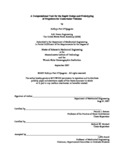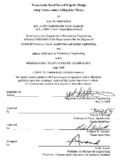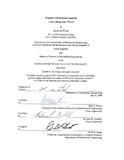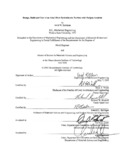A computational tool for the rapid design and prototyping of propellers for underwater vehicles
| dc.contributor.author | D'Epagnier, Kathryn Port. | |
| dc.date.accessioned | 2012-03-14T17:36:58Z | |
| dc.date.available | 2012-03-14T17:36:58Z | |
| dc.date.issued | 2007-09 | |
| dc.identifier.uri | https://hdl.handle.net/10945/3007 | |
| dc.description.abstract | An open source, MATLAB (trademarked)-based propeller design code MPVL was improved to include rapid prototyping capabilities as well as other upgrades as part of this effort. The resulting code, OpenPVL is described in this thesis. In addition, results from the development code BasicPVL are presented. An intermediate code, BasicPVL, was created by the author while OpenPVL was under development, and it provides guidance for initial propeller designs and propeller efficiency analysis. OpenPVL is part of the open source software suite of propeller design codes, Openprop. OpenPVL is in the form of a Graphical User Interface (GUI) which features both a parametric design technique and a single propeller geometry generator. This code combines a user-friendly interface with a highly modifiable platform for advanced users. This tool offers graphical propeller design feedback while recording propeller input, output, geometry, and performance. OpenPVL features the ability to translate the propeller design geometry into a file readable by a Computer Aided Design (CAD) program and converted into a 3D-printable file. Efficient propellers reduce the overall power requirements for Autonomous Underwater Vehicles (AUVs), and other propulsion-powered vehicles. The focus of this study is based on the need of propeller users to have an open source computer-based engineering tool for the rapid design of propellers suited to a wide range of underwater vehicles. Propeller vortex lattice lifting line (PVL) code in combination with 2D foil theory optimizes propeller design for AUVs. Several case studies demonstrate the functionality of OpenPVL, and serve as guides for future propeller designs. The first study analyzes propeller thruster performance characteristics for an off-the-shelf propeller, while the second study demonstrates the process for propeller optimization-from the initial design to the final file that can be read by a 3D printer. | en_US |
| dc.description.uri | http://archive.org/details/acomputationalto109453007 | |
| dc.format.extent | 95 p : ill. | en_US |
| dc.publisher | Cambridge Massachusetts Institute of Technology and the Woods Hole Oceanographic Institution, | en_US |
| dc.subject.lcsh | Propellers | en_US |
| dc.subject.lcsh | Submersibles | en_US |
| dc.subject.lcsh | Computer-aided design | en_US |
| dc.title | A computational tool for the rapid design and prototyping of propellers for underwater vehicles | en_US |
| dc.type | Thesis | en_US |
| dc.contributor.corporate | Massachusetts Institute of Technology and the Woods Hole Oceanographic Institution. | |
| dc.description.funder | Contract number: N62771-97-G-0026 | en_US |
| dc.description.service | US Naval Academy (USNA) author. | en_US |
| dc.identifier.oclc | 662521029 | |
| etd.thesisdegree.name | M.S. | en_US |
| etd.thesisdegree.level | Masters | en_US |
| etd.thesisdegree.discipline | Mechanical Engineering | en_US |
| etd.thesisdegree.grantor | Massachusetts Institute of Technology and the Woods Hole Oceanographic Institution | en_US |
| etd.verified | no | en_US |
| dc.description.distributionstatement | Approved for public release; distribution is unlimited. |
Files in this item
This item appears in the following Collection(s)
-
1. Thesis and Dissertation Collection, all items
Publicly releasable NPS Theses, Dissertations, MBA Professional Reports, Joint Applied Projects, Systems Engineering Project Reports and other NPS degree-earning written works.





